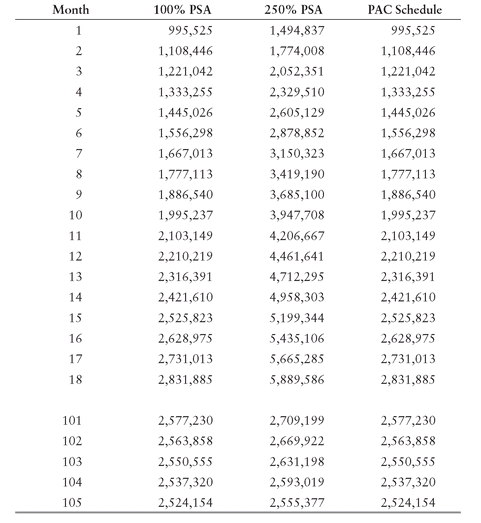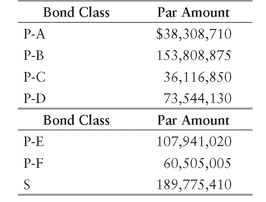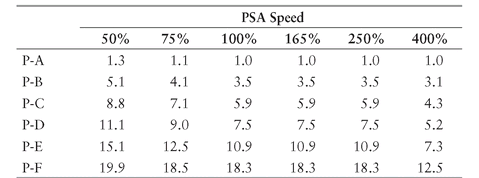PLANNED AMORTIZATION CLASS BONDS AND SUPPORT BONDS
There are institutional investors who seek securities (bond classes) that have even greater protection against prepayment risk. Investment bankers have created a product for such investors. To under- stand how this was done by structurers for investment banking firms, look at Table 3.3. The table shows the total principal payment for selected months for our $660 million, 6% collateral assuming a prepayment speed of 100% PSA (column 2) and 250% PSA (column 3). The last column in Table 3.3 shows the minimum total principal payment for each month. That is, if the prepayment speed is constant over the life of the collateral and that constant prepayment speed is
 between 100% PSA and 250% PSA, then the monthly total principal will be as shown in the last column. If the total of the principal in the last column is summed, it is equal to $470,224,580.
between 100% PSA and 250% PSA, then the monthly total principal will be as shown in the last column. If the total of the principal in the last column is summed, it is equal to $470,224,580.
TABLE 3.3 Total Principal Payments at 100% PSA and 250% PSA and Creation of PAC Schedule for Selected Months


The amounts in the last column allows a structurer to create a bond class, referred to as a planned amortization class bond (more popularly referred to as a PAC), which has priority over all other bonds classes in the structure with respect to receiving the scheduled principal repayment.19 For example, for our hypothetical $660 mil- lion, 5.5% pass-through security, using a lower prepayment speed of 100% PSA and an upper speed of 250% PSA, the PAC schedule would be shown in the last column. The upper and lower prepayment speeds are referred to as the structuring speeds and the range of 100% to 250% PSA is referred to as the structuring bands. The non-PAC bond classes in the structure are referred to as the support bonds or companion bonds, a name given because of their function in the structure as will be explained shortly.
The key in this structure is that the support bonds accept the contraction risk if actual prepayment speeds are fast and accept the extension risk if actual prepayments are slow. Hence, unlike in the sequential pay structure illustrated by Structure 1, where the bond classes are afforded some protection against extension risk or contraction risk but not both, PAC bonds offer prepayment protection against both extension risk and contraction risk.
The prepayment protection in a PAC structure comes from the support bonds. It is the support bonds that receive any excess principal payments beyond the scheduled amount to be paid to the PAC bond classes and must wait to receive principal if there is a principal shortfall—hence, the term support bonds to describe this bond class.
To understand the rules for distribution in a PAC structure, consider the following hypothetical structure below that we identify as “Structure 2”: Notice that the par amount in Structure 2 is the total for a PAC created with a structuring band band of 100% to 250% PSA.
Notice that the par amount in Structure 2 is the total for a PAC created with a structuring band band of 100% to 250% PSA.

Table 3.3 shows how this is done. Columns 2 and 3 show the monthly principal payments based on prepayment speeds of 100% and 250%, respectively. The last column shows the minimum principal payment for each month. The last column is the schedule of payments to the PAC bond class. It is this schedule, referred to as the PAC schedule, that would be shown in the prospectus.
To understand how the principal payment rules work for a PAC bond class, look at look at month 12. The PAC schedule indicates that for that month the payment to be made to the PAC bond class is $2,210,219. Suppose that actual principal payments for that month are $3,200,000. Then $2,210,219 is paid to the PAC bond class (P) and the balance, $989,781, is distributed to the support bonds.
The following table shows the average life at the time of issuance for the two bond classes:

Notice that the average life is unchanged for the PAC bond class prepayment speeds from 100% to 250% PSA, the structuring band. Also notice the considerable variation in the average life of the support bond class. Its variability is much greater than that of the collateral for the prepayments speeds shown. This is to be expected because the support bond class is providing prepayment protection for the PAC bond class.
Sequential Pay PAC Structure
In practice, a typical structure may have more than one class of PAC bonds. That is, there may be a series of PAC bonds. For example, consider the following structure that we will refer to as “Structure 3”:

The first six bond classes are PAC bonds and their total par value is $470,224,580, the same as the single PAC bond in Structure 2. The rules for the distribution of principal payments is in sequence as follows:
• Pay principal payments received from the collateral to P-A up to its scheduled amount and if there is any excess principal payments, then, if such excess principal payments do not exceed expected principal payments at 250 PSA, distribute them to S or else distribute them to P-A.
• After P-A is fully paid off, pay principal payments received from the collateral to P-B up to its scheduled amount and if there is any excess principal payments, then, if such excess principal payments do not exceed expected principal payments at 250 PSA, distribute them to S, or else, distribute them to P-B.
• After P-B is fully paid off, pay principal payments received from the collateral to P-C up to its scheduled amount and if there is any excess principal payments, then, if such excess principal payments do not exceed expected principal payments at 250 PSA, distribute them to S or else distribute them to P-C.
• And so on.
The average life for each PAC bond assuming various prepayment speeds is provided below:

Note that the average life is stable for the structuring band for all PAC bonds. This is as to be expected. But note further that the shorter-term PAC bonds such as P-A and P-B have stability over a wider range of prepayment speeds. The reason has to do with the support bonds. In Structure 2, there is $189,775,410 par value of support bonds protecting $470,224,580 par value of a single PAC bond. In Structure 3, since P-A has first priority on the principal payments, this means that from the perspective of P-A, there is $189,775,410 par value of support bonds protecting only $38,308,710 par value of P-A. Hence, there is greater prepayment protection beyond the structuring band. Similarly, for P-B, there is $189,775,410 par value of support bonds protecting only $192,117,585 (sum of par value of P-A and P-B). While the prepayment protection of P-B is provided for a wider range of prepayment speeds compared to the structuring bands, that range is less than for P-A, but greater than for P-C and P-D.
Types of Support Bonds
Because of their role in providing protection for PAC bond classes in a structure, support bonds have the greatest prepayment risk in a structure. Investors must be particularly careful in assessing the cash flow characteristics of support bonds to reduce the likelihood of adverse portfolio consequences due to prepayments. Unfortunately, in the early years of the CMO markets, too often buyers of these types of bond classes were not aware of their investment characteristics and were attracted to them because of their high yield based on some specified prepayment assumption rather than analyzing them on an option-adjusted basis.
In the PAC-support structure given by Structure 2, there is only one support bond. In actual deals, the support bonds are often divided into different bond classes. For example, a structurer can create support bonds that payoff in sequence. To provide some support bonds with greater prepayment protection than the other support bonds in a structure, a structurer can even carve up the support bonds to create support bonds with a schedule of principal repayments. That is, support bonds that are PAC support bonds can be created. In a structure with a PAC bond and a support bond with a PAC schedule of principal repayments, the former is called a PAC I bond or Level I PAC bond and the latter a PAC II bond or Level II PAC bond. While PAC II bonds have greater prepayment protection than the support bonds without a schedule of principal repayments, the prepayment protection is less than that provided PAC I bonds.
..................Content has been hidden....................
You can't read the all page of ebook, please click here login for view all page.
